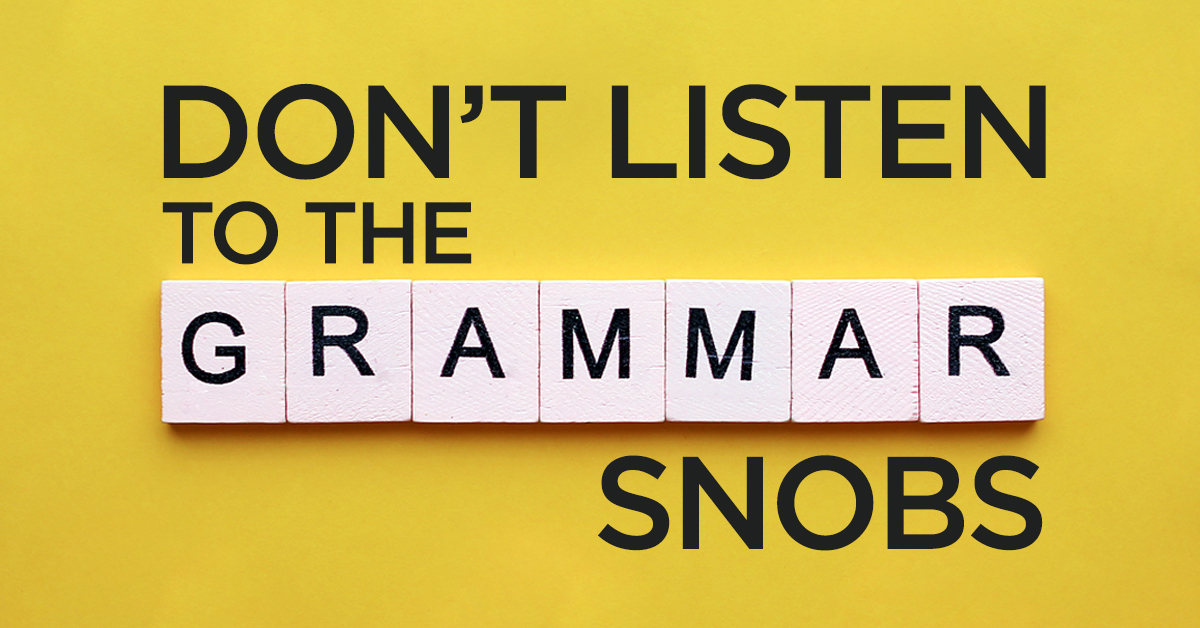How could you forget your high school English teacher? She inked up your papers, taught you to diagram sentences, and made you memorize the Preposition Song. You owe her one for helping you communicate intelligibly, but sometimes her memory is just a little bit much—like when you’re trying to write conversational copy and she’s there on your shoulder. She’s peering over her glasses, shaking her head, and making that tsk-tsk sound when you want to start a sentence with a conjunction.
The haunting ghost of your English teacher represents a familiar tug of war between prescriptive and descriptive grammar.
Prescriptive grammar focuses on established rules that dictate how language should be used. Your English teacher is all about prescriptive grammar, and rightly so. It’s important that everyone gets a solid framework for writing.
Descriptive grammar, on the other hand, focuses less on how grammar should be used and more on how it is used in daily conversation.
The prescriptive vs. descriptive grammar tension sets up a spectrum. For copywriters, where you sit on the spectrum may be client-dependent. If you’re writing for a company that sells skateboards to teenagers, your writing is going to be in a very different place on that spectrum than it would be for a medical company that sells arthritis medication.
In this article, we’ll review some of the grammar conventions that remain sacred and others that can be smashed with impunity.
Listen to Your English Teacher
Breaking some grammar rules can support the flow of your copy and help you connect with your target audience. Breaking other rules can make you (and by extension, the thing you are selling) sound rinky-dink and untrustworthy.
Listen to your English teacher to avoid these unforgivable errors:
Subject-Verb Disagreement. “Jenn and her friends is going to the store” hurts everyone’s ears. There’s not really a time when mixing up subject-verb agreement would be endearing. It just sounds uneducated, so make sure to get this one right.
Poor Parallelism. When referencing items in a series, make sure that they share the same grammatical structure.
Incorrect: “I enjoy cooking, baking, and all kinds of new kitchen gadgets.”
You started out with two gerunds so finish with one as well. A better construction would be: “I enjoy cooking, baking, and trying new kitchen gadgets.”
Apostrophe Mistakes. “It’s and its” may be the most common of these. Unless you can substitute “it’s” with “it is,” you don’t need an apostrophe. The apostrophe is only needed to create a contraction—not to show possession.
Incorrect: “The dog is cute. It’s name is Fido.”
Correct: “The dog is cute. Its name is Fido.”
Apostrophe errors can also be tricky with plural words. If a word is already plural, you just need to add an apostrophe at the end.
Incorrect: “The girls’s soccer team won.”
Correct: “The girls’ soccer team won.”
You should also use care with words that are already plural as those can create apostrophe challenges.
Incorrect: “The Peoples’ Choice Award,” “The womens’ soccer team”
Correct: “The People’s Choice Award,” “The women’s soccer team”
Mixed-up Homophones. These are words that sound the same but aren’t spelled the same, and in no case is it considered clever or conversational to mix them up. Rather, it can degrade your credibility. Among the most commonly confused homophones are their/they’re/there and you’re/your.
Listen to Your Audience
You may hear your English teacher pontificating on some of the softer rules of grammar, but don’t let her drown out your target audience. If you were alive in the 1980s, you might remember the Wendy’s slogan, “Ain’t no reason to go anyplace else.” That would tie your English teacher in knots, but it sold a lot of hamburgers.
To understand how to cater your voice to your customers, the most important thing you can do is research them. Research is the first step in my RMBC copywriting method to help you write higher grossing copy in less time. You can go on social media, online forums, and Amazon marketplace to get a feel for how your audience speaks and to better understand their desires and pain points. Check out this blog for more on that.
Depending on your audience, you may find that some of the grammar conventions below can be relaxed in order to make your voice resonate.
Sentence fragments. Using complete sentences is a good general rule, but occasional well-placed fragments can drive your message home. They can infuse rhythm and emphasize important points.
Not catchy: “Once you purchase four bottles, you’ll get the fifth bottle free.”
Catchy: “Four bottles, fifth one free. It’s that easy.”
Starting sentences with conjunctions. If you feel a twinge of guilt when you start a sentence with “and” or “but,” it means your English teacher did her job well. But there are plenty of times when flow is improved by breaking a sentence in two and starting the second sentence with a conjunction. (See what I did there.)
Split infinitives. Conventional grammar wisdom dictates that you should never break up an infinitive (to + verb) with an adverb or other word. Probably the most famous convention-breaker here is “to boldly go where no man has gone before,” made famous by the Star Trek title sequence. Though not technically correct, this catchy split infinitive hit home. Nearly 60 years after it was coined, it’s still ringing in our ears.
There are some cases where a split infinitive sounds better:
- “To more than double your investment”
- “To secretly admire” vs. “to admire secretly”
- “To quickly grow your investment” vs. “to grow your investment quickly”
Don’t risk making your copy sound clunky or less catchy just to adhere rigidly to this grammar rule.
Prepositions at the end of sentences.
“What are you waiting for?” vs. “For what are you waiting?”
“This is the investment you want to go with” vs. “This is the investment with which you want to go”
“There’s nothing to be afraid of” vs. “There’s nothing of which to be afraid”
You get the idea! Even though you may have been told that ending your sentence with a preposition is taboo, sometimes it just sounds better. Good emotional response marketing is built on being authentic. If your writing is too lofty or stilted, your connection with your target audience will suffer.
Sure, it’s nice to appease the memory of your English teacher, but your ultimate goal in freelance copywriting is to lead your reader to a desired response. Keep that as your North Star as you strike the right balance between prescriptive and descriptive grammar.




0 Comments